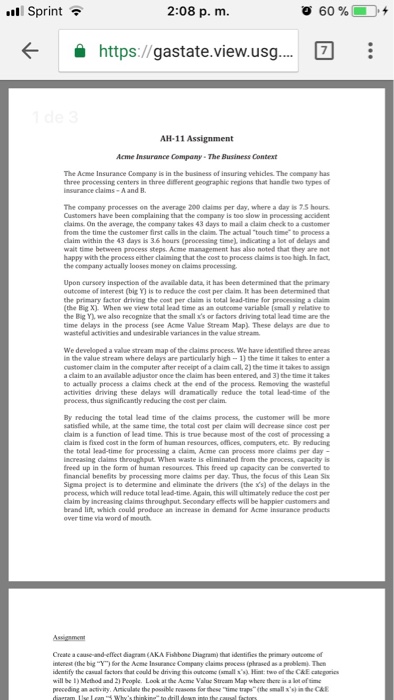Sprint 2:08 p. m. https://gastate.view.usg D AH-11 Assignment Acme Insurance Company- The Business Context The Aome Insurance Company is in the business of insuring vehicles. The company has three processing centers in three different geographic regions that handle two types of insurance claims The company processes on the average 200 claims per day, where a day is 7.5 houns Customers have been complaining that the company is too slow in processing aecident claims. On the average, the company takes 43 days to mail a claim check to a customer from the time the customer first calls the claim Te actual "touch time" to process a claim within the 43 days is 3.6 hours (processing time) Indicating a lot of delays and wait time between process steps. Acme manapement has also noted that they are not happy with the process either claiming that the cost to precess daims is too high In fact the company actually looses money on claims processing Upon curseey inspection of the available data, it has been determined that the primary outcome of interest (big Y) is to reduce the cost per claim It has been determined that the primary factor driving the cost per claim is total lead-time for processing a clai (the Big X) When we view total lead time as an outcome variable (small y relative to the Big Y), we also recognixe that the small x's or factors driving total lead time are the time delays in the process [see Acme Valee Stream Map) These delays are due to wasteful activities and undesirable variance", th value stream We developed a value stream map of the claims process. We have identified three areas in the value stream where delays are particularly high 1) the time it takes to enter a customer daim in the computer after receipt of a claim call, 2) the time it takes to assip a claim to an available adjuster once the claim has been entered, and 3) the time it takes to actually process a claims check at the end of the process. Removing the wastefl activities driving these delays will dramatically reduce the total lead-time of the process, thus significantly reducing the cest per claim. By reducing the total lead time of the claims process, the customer will be more satised while, at the same time, the total cost per claim will decrease since cost per daim is a function of lead time. This is true because most of the cost of processing a dlaim is fixed cest in the form of human resources, effices, computers, etc. By reducing the total lead-time for processing a claim Acme can process more claims per day Increasing dlaims throughput When waste is eliminated firom the process, capacity is freed up in the form of human resources This freed up capacity can be converted to financial benefits by processing more cdaims per day. Thus, the focus of this Lean Six Sigma project is to determine and eliminate the drivers (the x's) of the delays in the process, which will reduce total lead-time Again, this will utimately reduce the cost per dlaim by increasing claims throughput. Secondary effects will be happier customers and brand lift, which coud produce an increase in demand for Acme insurance products over time via word of mouth Create a case and-effect diagran (AKA Fishbone Diagram) that identifies the peimary oulcome of imerest (thebigYfor the Neme Insurance Company claims peocess (phrased as a peoblem. Thc identify the casual factors that could be driving this outcome (small s's Hint: twe of the CkE calegories will be 1) Method and 2 People. Look at the Aeme Valuc Stream Map whene thee is a lot of time preceding an activity, Aniculate the possible reasons for these "time traps"the mall's) n the C& Sprint 2:08 p. m. https://gastate.view.usg D AH-11 Assignment Acme Insurance Company- The Business Context The Aome Insurance Company is in the business of insuring vehicles. The company has three processing centers in three different geographic regions that handle two types of insurance claims The company processes on the average 200 claims per day, where a day is 7.5 houns Customers have been complaining that the company is too slow in processing aecident claims. On the average, the company takes 43 days to mail a claim check to a customer from the time the customer first calls the claim Te actual "touch time" to process a claim within the 43 days is 3.6 hours (processing time) Indicating a lot of delays and wait time between process steps. Acme manapement has also noted that they are not happy with the process either claiming that the cost to precess daims is too high In fact the company actually looses money on claims processing Upon curseey inspection of the available data, it has been determined that the primary outcome of interest (big Y) is to reduce the cost per claim It has been determined that the primary factor driving the cost per claim is total lead-time for processing a clai (the Big X) When we view total lead time as an outcome variable (small y relative to the Big Y), we also recognixe that the small x's or factors driving total lead time are the time delays in the process [see Acme Valee Stream Map) These delays are due to wasteful activities and undesirable variance", th value stream We developed a value stream map of the claims process. We have identified three areas in the value stream where delays are particularly high 1) the time it takes to enter a customer daim in the computer after receipt of a claim call, 2) the time it takes to assip a claim to an available adjuster once the claim has been entered, and 3) the time it takes to actually process a claims check at the end of the process. Removing the wastefl activities driving these delays will dramatically reduce the total lead-time of the process, thus significantly reducing the cest per claim. By reducing the total lead time of the claims process, the customer will be more satised while, at the same time, the total cost per claim will decrease since cost per daim is a function of lead time. This is true because most of the cost of processing a dlaim is fixed cest in the form of human resources, effices, computers, etc. By reducing the total lead-time for processing a claim Acme can process more claims per day Increasing dlaims throughput When waste is eliminated firom the process, capacity is freed up in the form of human resources This freed up capacity can be converted to financial benefits by processing more cdaims per day. Thus, the focus of this Lean Six Sigma project is to determine and eliminate the drivers (the x's) of the delays in the process, which will reduce total lead-time Again, this will utimately reduce the cost per dlaim by increasing claims throughput. Secondary effects will be happier customers and brand lift, which coud produce an increase in demand for Acme insurance products over time via word of mouth Create a case and-effect diagran (AKA Fishbone Diagram) that identifies the peimary oulcome of imerest (thebigYfor the Neme Insurance Company claims peocess (phrased as a peoblem. Thc identify the casual factors that could be driving this outcome (small s's Hint: twe of the CkE calegories will be 1) Method and 2 People. Look at the Aeme Valuc Stream Map whene thee is a lot of time preceding an activity, Aniculate the possible reasons for these "time traps"the mall's) n the C&







